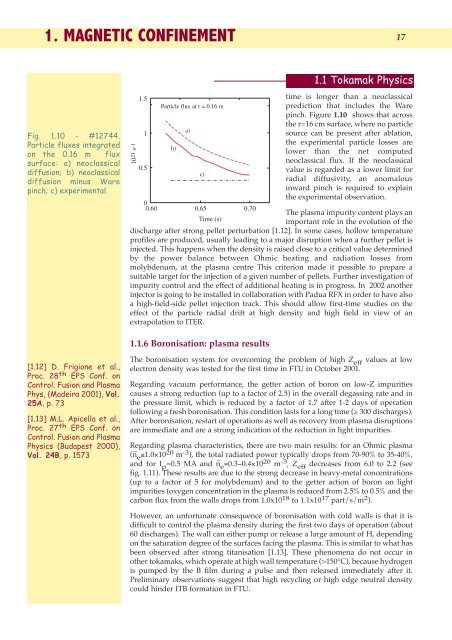1. magnetic confinement - ENEA - Fusione
1. magnetic confinement - ENEA - Fusione
1. magnetic confinement - ENEA - Fusione
You also want an ePaper? Increase the reach of your titles
YUMPU automatically turns print PDFs into web optimized ePapers that Google loves.
<strong>1.</strong> MAGNETIC CONFINEMENT<br />
17<br />
<strong>1.</strong>1 Tokamak Physics<br />
Fig. <strong>1.</strong>10 - #12744.<br />
Particle fluxes integrated<br />
on the 0.16 m flux<br />
surface: a) neoclassical<br />
diffusion; b) neoclassical<br />
diffusion minus Ware<br />
pinch; c) experimental.<br />
<strong>1.</strong>5<br />
time is longer than a neoclassical<br />
Particle flux at r = 0.16 m<br />
prediction that includes the Ware<br />
pinch. Figure <strong>1.</strong>10 shows that across<br />
the r=16 cm surface, where no particle<br />
a)<br />
1<br />
source can be present after ablation,<br />
the experimental particle losses are<br />
b)<br />
lower than the net computed<br />
neoclassical flux. If the neoclassical<br />
0.5<br />
value is regarded as a lower limit for<br />
c)<br />
radial diffusivity, an anomalous<br />
inward pinch is required to explain<br />
the experimental observation.<br />
0<br />
0.60<br />
0.65<br />
0.70<br />
The plasma impurity content plays an<br />
Time (s)<br />
important role in the evolution of the<br />
discharge after strong pellet perturbation [<strong>1.</strong>12]. In some cases, hollow temperature<br />
profiles are produced, usually leading to a major disruption when a further pellet is<br />
injected. This happens when the density is raised close to a critical value determined<br />
by the power balance between Ohmic heating and radiation losses from<br />
molybdenum, at the plasma centre This criterion made it possible to prepare a<br />
suitable target for the injection of a given number of pellets. Further investigation of<br />
impurity control and the effect of additional heating is in progress. In 2002 another<br />
injector is going to be installed in collaboration with Padua RFX in order to have also<br />
a high-field-side pellet injection track. This should allow first-time studies on the<br />
effect of the particle radial drift at high density and high field in view of an<br />
extrapolation to ITER.<br />
1021 s-1<br />
<strong>1.</strong><strong>1.</strong>6 Boronisation: plasma results<br />
[<strong>1.</strong>12] D. Frigione et al.,<br />
Proc. 28 th EPS Conf. on<br />
Control. Fusion and Plasma<br />
Phys, (Madeira 2001), Vol.<br />
25A, p. 73<br />
[<strong>1.</strong>13] M.L. Apicella et al.,<br />
Proc. 27 th EPS Conf. on<br />
Control. Fusion and Plasma<br />
Physics (Budapest 2000),<br />
Vol. 24B, p. 1573<br />
The boronisation system for overcoming the problem of high Z eff values at low<br />
electron density was tested for the first time in FTU in October 200<strong>1.</strong><br />
Regarding vacuum performance, the getter action of boron on low-Z impurities<br />
causes a strong reduction (up to a factor of 2.5) in the overall degassing rate and in<br />
the pressure limit, which is reduced by a factor of <strong>1.</strong>7 after 1-2 days of operation<br />
following a fresh boronisation. This condition lasts for a long time (≥ 300 discharges).<br />
After boronisation, restart of operations as well as recovery from plasma disruptions<br />
are immediate and are a strong indication of the reduction in light impurities.<br />
Regarding plasma characteristics, there are two main results: for an Ohmic plasma<br />
(n _ e ≤<strong>1.</strong>0×1020 m -3 ), the total radiated power typically drops from 70-90% to 35-40%,<br />
and for I p =0.5 MA and n _ e =0.3−0.4×1020 m -3 , Z eff decreases from 6.0 to 2.2 (see<br />
fig. <strong>1.</strong>11). These results are due to the strong decrease in heavy-metal concentrations<br />
(up to a factor of 5 for molybdenum) and to the getter action of boron on light<br />
impurities (oxygen concentration in the plasma is reduced from 2.5% to 0.5% and the<br />
carbon flux from the walls drops from <strong>1.</strong>0x10 18 to <strong>1.</strong>1x10 17 part/s/m 2 ).<br />
However, an unfortunate consequence of boronisation with cold walls is that it is<br />
difficult to control the plasma density during the first two days of operation (about<br />
60 discharges). The wall can either pump or release a large amount of H, depending<br />
on the saturation degree of the surfaces facing the plasma. This is similar to what has<br />
been observed after strong titanisation [<strong>1.</strong>13]. These phenomena do not occur in<br />
other tokamaks, which operate at high wall temperature (>150°C), because hydrogen<br />
is pumped by the B film during a pulse and then released immediately after it.<br />
Preliminary observations suggest that high recycling or high edge neutral density<br />
could hinder ITB formation in FTU.













